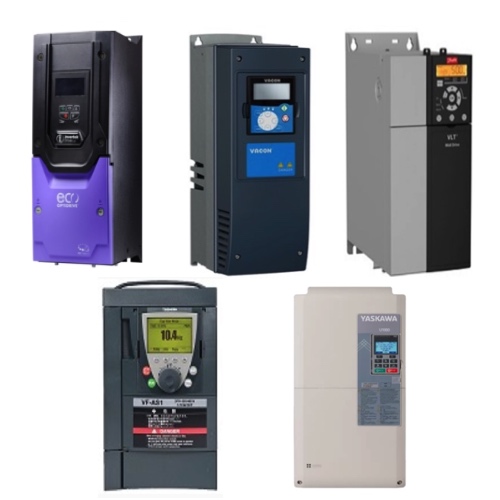VFD Variable Frequency Drives

RSP Supply carries a full line of variable frequency drives (VFDs) designed for precise motor control, optimized speed regulation, and improved energy efficiency in industrial and commercial systems. VFDs adjust the power supplied to AC motors, allowing for exact control of speed and torque, making them essential in processes that require accuracy, reliability, and performance. These intelligent motor controllers not only enhance productivity but also significantly reduce energy consumption and equipment stress, extending the life of both motors and mechanical components such as pumps, gears, and fans.
At RSP Supply, we understand that every application has unique demands -which is why we carry a full range of trusted VFD brands to fit your exact needs. Our lineup includes ABB, Benshaw, Danfoss, Eaton, NAE, Schneider Electric, Toshiba, and Yaskawa, along with VFD cables and accessories to complete your setup. Whether you’re upgrading an existing setup or designing a new one, our team can guide you to reliable, high-efficiency solutions that make a measurable difference in your operation.
Overview: Variable Frequency Drives (VFDs)
Variable Frequency Drives (VFDs) are advanced motor control devices designed to regulate the speed and torque of electric motors by adjusting the frequency and voltage of the power supplied. Instead of operating motors at a constant full speed, VFDs allow motors to run only as fast as the application requires, improving efficiency and performance. One of the most significant advantages of VFDs is energy savings. In applications such as pumps, fans, and compressors where load demand frequently changes, VFDs can reduce energy consumption by 40% or more compared to traditional direct-on-line operation. This not only lowers operating costs but also reduces greenhouse gas emissions and supports sustainability goals.
Beyond energy efficiency, VFDs improve overall system reliability and equipment lifespan. By providing soft starts and controlled stopping, they reduce mechanical stress, limit electrical surges, and minimize wear on motors and connected components. This leads to lower maintenance requirements, fewer breakdowns, and increased uptime. VFDs are used across a wide range of industries, including HVAC, water and wastewater treatment, manufacturing, material handling, marine systems, and renewable energy. Their ability to enhance process control, optimize performance, and deliver rapid return on investment makes them a critical component in modern industrial and commercial motor-driven systems.
FAQs
Q: What is a variable frequency drive (VFD)?
A VFD is a motor control device that adjusts the frequency and voltage supplied to an AC motor, allowing precise control of motor speed and torque.
Q: How do VFDs improve energy efficiency?
VFDs reduce energy consumption by allowing motors to run only at the speed required for the application instead of operating at full speed continuously.
Q: How much energy can a VFD realistically save?
Energy savings of 30–60% are common in applications like pumps and fans, with some systems achieving even higher savings depending on load variability and operating hours.
Q: How do VFDs reduce equipment wear?
By providing soft starts, controlled stops, and smooth speed changes, VFDs reduce mechanical stress and electrical strain on motors and connected components.
Q: What brands of VFDs are available from RSP Supply?
RSP Supply offers VFDs from ABB, Benshaw, Danfoss, Eaton, NAE, Schneider Electric, Toshiba, and Yaskawa.
Why Buy Variable Frequency Drives from RSP Supply
RSP Supply offers a comprehensive selection of variable frequency drives and accessories from trusted manufacturers. Our product lineup supports precise motor control, improved energy efficiency, and reliable performance across a wide range of industrial and commercial applications.

